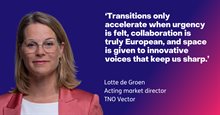Collaborative ecosystem development as an approach to facilitate digital strategic autonomy
Geopolitical tensions make digital strategic autonomy more urgent than ever. TNO Vector shows how collaboration between government and industry enables both control and innovation. Discover in this report the six-step framework and real-world examples that strengthen the resilience of your digital future.
The challenge: balancing autonomy and innovation
Digital strategic autonomy can be defined as having ’control over the design and use of (business) critical digital systems, algorithms and the data generated and processed with them’. This means that nations face a dual challenge:
- Reliance on foreign suppliers exposes critical infrastructure to geopolitical risks, from export controls to cyber threats.
- Domestic suppliers struggle to compete on cost and scale, often lacking the market size or predictable demand needed to innovate and thrive.
Governments have policy tools and budgets, but often lack the technical agility and expertise to develop cutting-edge technologies in-house. Meanwhile, private companies possess the expertise and innovation capacity but need stable demand and supportive partnerships to justify investments in sovereign capabilities.
Traditional solutions, like procurement diversification or regulation, fall short. What’s needed is a new model of collaboration that bridges public objectives with private incentives.
Bridging the gap through collaboration
One way to achieve digital strategic autonomy is through a concerted approach that leverages the complementary strengths of the public and private sectors. A purely state-driven model risks bureaucratic inertia, while unregulated markets may overlook national security imperatives. Purposeful collaboration can therefore be essential to align public objectives with commercial incentives, fostering domestic capacity without compromising innovation or efficiency. In other words, to ensure that critical domestic industries can reliably deliver critical digital products and services, governments must move beyond buyer-vendor relationships and more toward robust public-private collaborations.
A six-step framework towards resilient ecosystems
TNO Vector introduces a six-step framework for building public-private ecosystems that foster trust, shared responsibility, and long-term alignment. This approach moves beyond transactional procurement to create resilient, self-sustaining partnerships where:
- Governments take ownership over the orchestration of ecosystems to secure strategic control.
- Industry co-creates solutions, ensuring commercial viability and innovation.
- Both sectors share risks and rewards, from R&D to deployment.
Collaborative Business Modeling (CBM) is at the heart of this process. CBM is an iterative, trust-based, evidence-based method where public and private partners co-design business models that balance security of supply with market-driven growth. TNO Vector has decade-spanning experience with the design and operationalization of CBMs. By aligning incentives and establishing clear governance, CBM ensures that ecosystems remain adaptive, competitive, and aligned with national priorities.
Lessons from real-world cases
Our framework is not theoretical: it’s built on successful case studies, including:
- Initiatives to develop European digital infrastructure through open-source collaboration.
- Public-private partnerships in radar technology and cryptography, where long-term commitments have secured domestic leadership.
- Data-sharing ecosystems that combine regulatory alignment with industry innovation.
These cases demonstrate how strategic collaboration can turn policy goals into tangible outcomes: stronger supply chains, reduced dependencies, and shared economic growth. The core takeaways are:
- Public-private collaborations are a key tool for achieving strategic digital autonomy. For many technological domains, governments need to rely on private sector expertise and capabilities to achieve strategic digital autonomy quickly. In such instances, public-private collaboration is key.
- Invest in co-creation. Both policymakers and industry leaders must be ready to invest in building collaborative ecosystems through co-creative process such as collaborative business modeling.
- Aligning public and private interests is crucial. For the industry to effectively contribute to Nation state’s digital autonomy, governments and businesses need to carefully configure and align their (often symbiotic) business models.
- Collaborative business modeling (CBM) helps building resilient ecosystems. This iterative process, founded on trust and relational principles like long-term commitment, shared responsibility, and transparency, balances public needs for value chain control and security of supply with the private sector's need for certainty and a clear business case for the involved industry.
Turn insights into action
The path to digital strategic autonomy starts with collaboration. Our paper provides a roadmap to:
- Design ecosystems that balance control and innovation.
- Implement governance models that work for all stakeholders.
- Adapt to evolving geopolitical and technological landscapes.
Ready to explore how collaborative ecosystems can secure your digital future?
Download the full paper to dive into our framework, case studies, and recommendations. Contact us to discuss how we can tailor this approach to your organization’s needs.





